TRUST BUILDING AMONG INDO-PACIFIC LAND FORCES FOR RISK REDUCTION
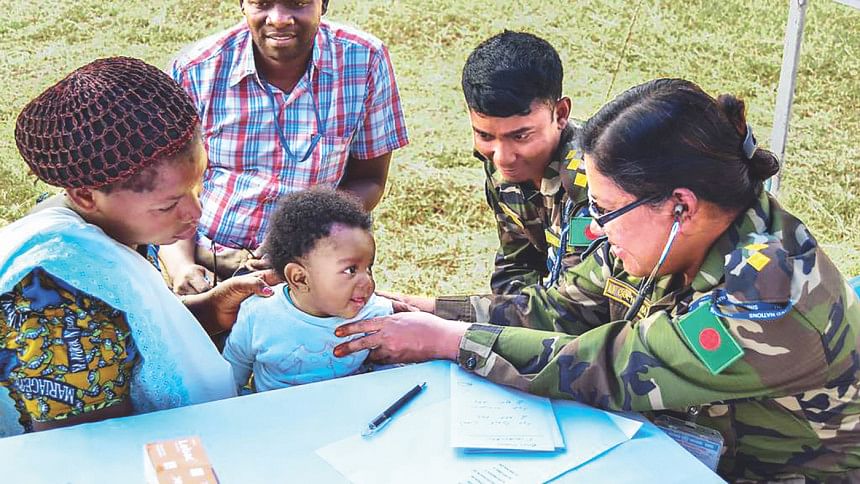
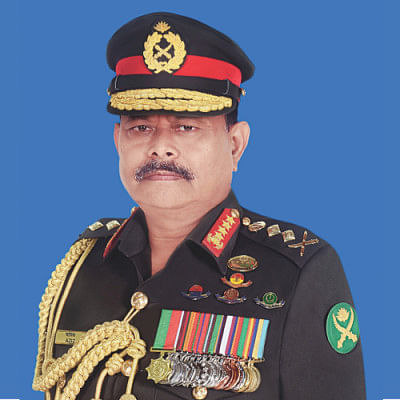
The Indo-Pacific region is one of the most dynamic regions of the world. It is a region, which is situated at the strategic crossroads, where genuine opportunities meet actual challenges. The region is experiencing unique economic growth for decades. On the one hand, the economic growth of the region opens up opportunities of partnership to alleviate poverty and raise living standards of billions of people. On the other hand, the growth of material powers of the countries, i.e. economic and military powers - require avoiding deepening suspicion and mistrust amongst each other. In fact, it is the time to build ‘Strategic Trust’ in the region, that is - belief and cooperation between countries to minimise divergences, on the way to building peace and stability in the region. In doing so, mutual understanding and developing trust between Armed Forces in general and Land Forces in particular of this region can be an important determinant.
Developing trust among land forces especially those sharing a common international boundary is perhaps easier in theory than in practice due to a host of reasons — border disputes, presence of non-state actors, transnational crimes, criminal activities, etc. Absence of cooperation or sharing information can breed social disorder, violence and also terrorism that would not be limited to any specific country but may affect the entire region. Therefore, it is essential that we reduce divergence and build trust amongst our nations. I had the unique opportunity to experience such issues for almost four years being the Director General of Border Guard Bangladesh.

All dimensions of security, whether politico-military, environmental or human are interlinked. In the 21st Century, the major threats — be it traditional or non-traditional — do not discriminate or recognise borders. No nation can meet these challenges alone. Military, being one of the core instruments of national power, has a vital role in ensuring the security of our nations. We cannot achieve it through the application of combat power against each other; instead, we can deliver it through collaboration, sharing knowledge and expertise, and understanding each other.
Our constitution based foreign policy states that Bangladesh shall determine its international relations on the principles of respect for national sovereignty and equality, non-interference in the internal affairs of other countries, peaceful settlement of disputes, respect for international norms, and the principles stated in the United Nations Charter. After our independence in 1971, the Father of the Nation Bangabandhu Sheikh Mujibur Rahman said: ‘We want friendship to all and malice towards none’. This ideology laid the foundation of our foreign relations, and Bangladesh is still pursuing this in letter and spirit.

BORDERS WITH INDIA AND MYANMAR
Bangladesh has a total of 4,427 km of land and river boundary with its two neighbours: India and Myanmar. The lion’s share of our border is with India, which is about 94 per cent. The remaining 271 km border with Myanmar runs along the River Naaf for 63 km and then through the hilly terrain for 208 km.
RESOLUTION OF BORDER ISSUES WITH INDIA
India and Bangladesh had three border-related issues: enclaves, adverse possession of territory and a small stretch of 6.5 km un-demarcated boundary. India and Bangladesh signed the 1974 Land Boundary Agreement (LBA) to resolve outstanding issues. This Agreement was amended in 2011 by an additional Protocol. The LBA entered into force on June 6, 2015.
India had 111 enclaves within Bangladesh, and Bangladesh had 51 enclaves in India. Under the terms of the LBA, both the countries transferred these enclaves. The inhabitants of the enclaves were given the right to remain on the territories as nationals of the State to which the territories were transferred.

Adverse possession, as the name suggests—is a piece of land that belongs to one country but is in the control of another country. Both Bangladesh and India had more than 3,000 acres of land each as adverse possession which was exchanged amicably.
There was 6.5 km un-demarcated border with India of which, 4.5 km border has already been settled, and the remaining 2 km will be resolved soon.
Implementation of the LBA has given the people living in the enclaves access to the essential services which were unavailable for more than 60 years due to the isolated nature of the territories. Implementation of the LBA also demonstrates how States can resolve issues with mutual respect yet maintain their national interest.

CHALLENGES OF BORDER MANAGEMENT
There are, of course, challenges associated with border management. Our border being porous poses many problems for the border guarding forces. Border areas are socio-economically underdeveloped, and dwellers of bordering regions generally do not have required education and economic opportunities, which at times entice them to get involved in informal trade, violating state rules and regulations.
There are insurgent groups in neighbouring countries operating close to our border that may take advantage of the porous and inaccessible border and may attempt to cross the border unnoticed whenever they are targeted and chased. They are causing political disturbances in their home country and may also create strained relation between neighbours.
Bangladesh is located at the heart of three drug-producing regions: in the east, the Golden Triangle, in the north, the Golden Wedge and in the west, across India, the Golden Crescent. The proximity of these regions is a significant factor that makes Bangladesh vulnerable to drug trafficking. Recently ‘Forcibly Displaced Myanmar Nationals’ have found to be involved in drug trafficking.
Being in the midst of the Golden Triangle, the Golden Wedge and the Golden Crescent, Bangladesh is vulnerable to be used as a transit route by transnational militant and insurgent outfits for smuggling arms and ammunition.
Human trafficking is a global problem, and Bangladesh is no exception to this. Illegal trafficking of mostly women and children across the border is causing social problem and insecurity. Women and children of the ‘Forcibly Displaced Myanmar Nationals’ are potential targets of human traffickers.
Smuggling is the most common issue for the border guards. A considerable quantity of products mainly cattle, clothes, etc. are smuggled from India and Myanmar to Bangladesh through various routes. Another high value smuggled item is gold, which is used as a means of payment of informal trade. Circulation of fake currency by transnational criminals through bordering areas is another concern which contributes to inflation.
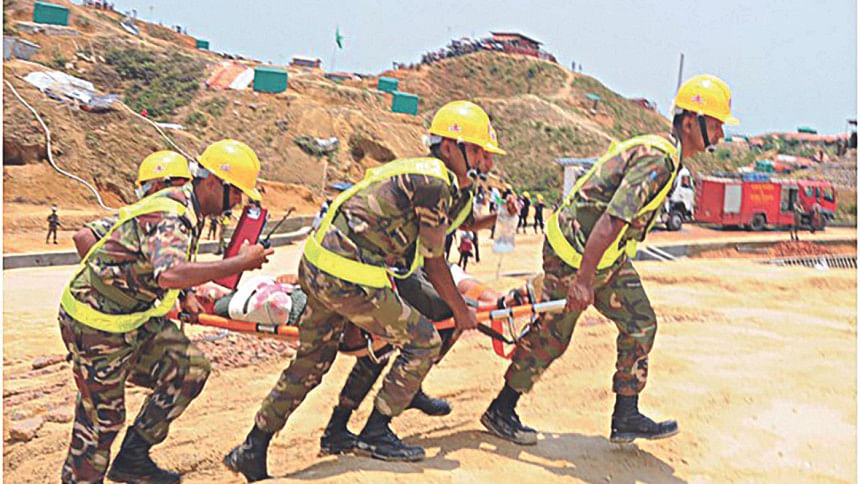
REDUCTION OF MISCALCULATION/CONFLICTS
There are several ways to reduce miscalculation and avert conflicts. The important ones deserve attention. Respecting sovereignty and territorial integrity of bordering countries is a precondition for building trust and avoiding confrontation which has been reflected in our words and deeds.
Bangladesh has never done anything that can be considered provocative for others. Bangladesh never allows its territory as sanctuary for extremists, terrorists and insurgents for perpetrating violence in other countries including India and Myanmar.
Bangladesh firmly believes in the peaceful settlement of disputes, which has been reflected in our commitment. Being a developing nation, we are leading the global efforts to maintain peace and security of the world by being one of the highest troops contributors to various United Nations Peace Operations. Implementation of the LBA with India testifies to our stance on peaceful settlement of disputes. Settlement of maritime boundaries harmoniously with India and Myanmar is another example of our firm belief in rules-based international order. International Tribunal for the Law of the Seas (ITLOS) delivered verdict on the maritime boundary dispute between Bangladesh and Myanmar on March 14, 2012 and the Permanent Court of Arbitration gave the verdict about the maritime boundary disputes between Bangladesh and India on July 7, 2014. Bangladesh’s approach to resolving the current Rohingya crisis amicably further testifies to our respect for peaceful settlement of disputes.
We have an excellent working relationship with the BSF of India which is missing in the case of Myanmar. To make the environment conducive, after assuming command of BGB, I immediately visited Myanmar and also invited Myanmar Border Guard Police Chief to visit Bangladesh for the first time after our independence, in 1971. My visit to Myanmar played a pivotal role to establish direct communication between two forces. Following the chief level meeting, bi-annual meeting between senior officers of both the forces is continuing till today. Sector and battalion level meetings are also organised quarterly or as and when required.
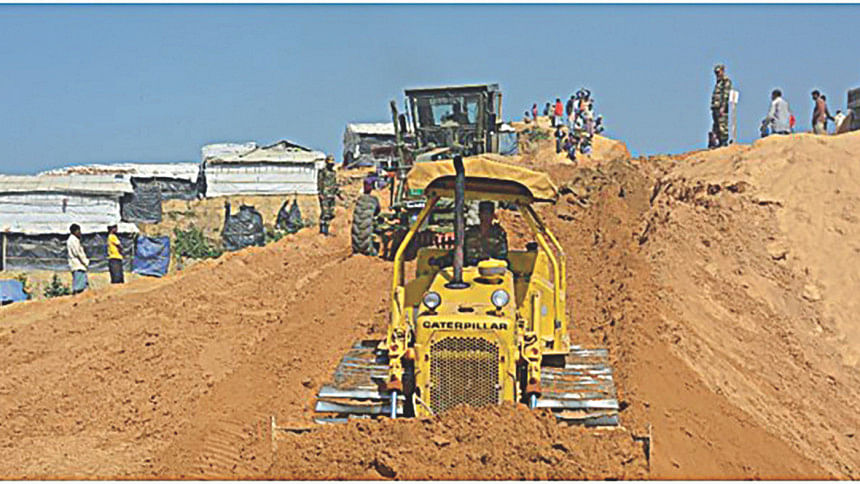
Information sharing between the bordering forces at the top level has had a cascading effect at functional level between border guarding forces of Bangladesh and India. Information sharing at lateral and parallel level of command has ensured success in the drive against smugglers, human traffickers, insurgents, extremists, and criminals which have defused tension,removed misunderstanding and developed trust and confidence. For example, whenever we obtained some information about smuggling or human trafficking inside India, we shared this with BSF, and they took appropriate measures. We also rescued the victims of human trafficking from India with the help of BSF. Eventually, it developed mutual trust between the two forces. We are also trying to develop same level of information sharing with Myanmar.
The Coordinated Border Management Plan (CBMP) signed in 2011 aims to synergise the efforts of both the border guarding forces for checking cross border illegal activities and crimes as well as for maintenance of peace and tranquillity along the India-Bangladesh border. Following the guideline of CBMP, a joint team finalised a list of 366 vulnerable stretches/patches along the entire border for extra vigilance. Coordinated Patrolling is carried out by both the border guarding forces and special attention is given to guard/observe those vulnerable patches. Recently this has been started with BGP of Myanmar as well. It is giving dividend in curbing transnational crimes including misunderstanding.
The border conferences or flag meetings with counterparts at grassroots levels are held at regular intervals or as and when required. Such meetings are considered to be an effective tool for resolving the border issue and also for developing mutual understanding and confidence between the forces on the ground.
As part of confidence-building measures, exchange of greetings, frequent courtesy meetings at battalion and company level even without any issue generates the desired level of trust between the border guarding forces of Bangladesh and India. Games and sports, cultural programmes, exchange of training, shooting competitions, seminars related to border management and visits by various delegations including members of family welfare association and school children are arranged to ensure continued and enhanced interaction. As a gesture of friendship, critical BGB patients receive advanced treatment in reputed BSF hospitals in India. As the Director-General of BGB, I was the first overseas “Chief Guest” in the history of BSF to review the passing out parade at BSF Academy Tekanpur in the Indian state of Madhya Pradesh on August 8, 2015. Following Bangladesh-Indian model we have started various confidence-building measures like exchange of visits, games and sports, etc with BGP of Myanmar as well.
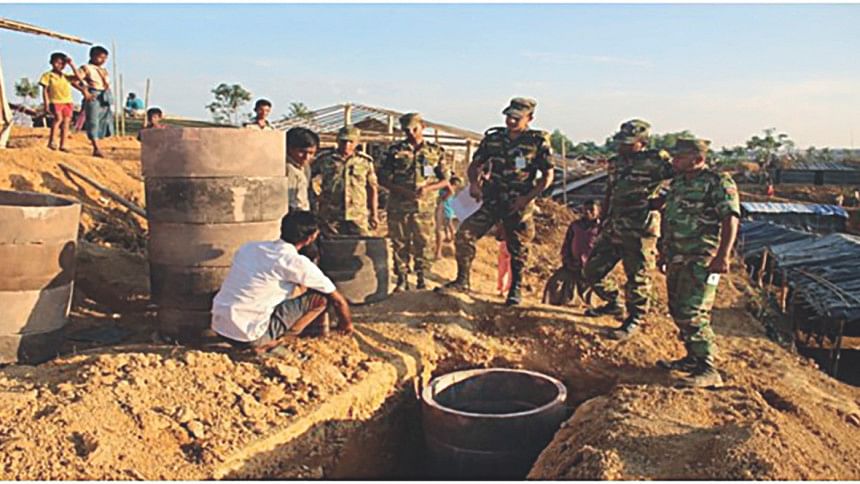
HUMANITARIAN SUPPORT FOR ‘FORCIBLY DISPLACED MYANMAR NATIONALS’
Currently, 1.1 million ‘Forcibly Displace Myanmar Nationals’ are stationed in 31 camps covering an area of 6,500 acres. Bangladesh Army provided shelter, life-saving treatment, food and water, and managed the trauma. The army is also ensuring physical security of the camps and coordinating the relief operations of other national and international agencies. Army is also playing a leading role in mitigating disaster risk at Rohingya camps which are prone to landslide, cyclone and flash flood being located near the coastal areas. Bangladesh Army facilitated UNHCR, IOM, other UN agencies and NGOs/INGOs to start and continue their humanitarian activities. Along with the humanitarian operations it is important to note what Bangladesh Army is doing in reducing tension between two neighbouring states.
We established direct communication with Myanmar military leadership. Besides direct contact at the strategic level, concerns are also intimated to Myanmar through different channels. Such communication played a meaningful role in maintaining normalcy, avoiding misunderstanding and reducing tension in the border.
To develop mutual trust, cooperation, training activities, and develop a roadmap for future engagements between two forces, the first staff talks were held in Dhaka on June 2017. Now we are pursuing Myanmar to conduct the second staff talks in Myanmar.
I have already been invited by the Commander in Chief of Myanmar Army to visit Myanmar in December this year and I have also invited the Myanmar Commander in Chief and Myanmar Army Chief to visit Bangladesh.
National and international media has the full freedom to ensure a free flow of information which helped the world community to get an accurate picture of the sufferings of the ‘Forcibly Displaced Myanmar Nationals’ and the role of our Government and the Army in humanitarian operations.
A FEW SUGGESTIONS
In view of the above discussions, a few measures may be useful in developing and maintaining trust among land forces of the Indo-Pacific region. Respect for each other’s sovereignty and territorial integrity in words and deeds can keep our region secure and stable.
Sharing of information at various levels among security agencies are required to defuse tension, eliminate misunderstanding and develop trust and confidence. Regular meetings may be held at the level of ‘National Security Chiefs’, ‘Army Chiefs’, and ‘Border Guard Heads’ to strengthen relations among law enforcement, intelligence and security agencies as part of curbing extremism, terrorism and transnational crimes. Coordinated border patrolling along the border can contribute significantly to developing trust and mutual respect between forces operating on the ground.
Exchange programmes and joint exercises can contribute significantly to developing trust and mutual respect between forces as well as countries. To strengthen further cooperation, exchange programme among training institutions may be planned among the Indo-Pacific land forces at regular intervals. Issues like technology and Excess Defence Article transfer, knowledge sharing, increased exchange programs, and collaboration in ‘operations other than war’ can contribute to capacity building of armies of this region.
CONCLUSION
We live in an interconnected world in which our security is now permanently linked to that of others. Security within the region should be sustainable as far as possible in order to maintain stability and development. The Indo-Pacific region where we belong has flourished over a considerable period under an international rules-based order that allows access to seas and airways, fair trade, etc. Developing trust among Indo-Pacific Land Forces in the region can keep areas secure and ensure a better future for our next generation.
----------------------------------------------------
Excerpt from the speech of General Aziz Ahmed, BSP, BGBM, PBGM, BGBMS, psc, G, Chief of Army Staff, Bangladesh Army at the Indo-Pacific Armies Chiefs Conference (IPACC XI) held in Bangkok, Thailand on 09 September 2019. This article is exclusive to The Daily Star.

 For all latest news, follow The Daily Star's Google News channel.
For all latest news, follow The Daily Star's Google News channel. 



Comments